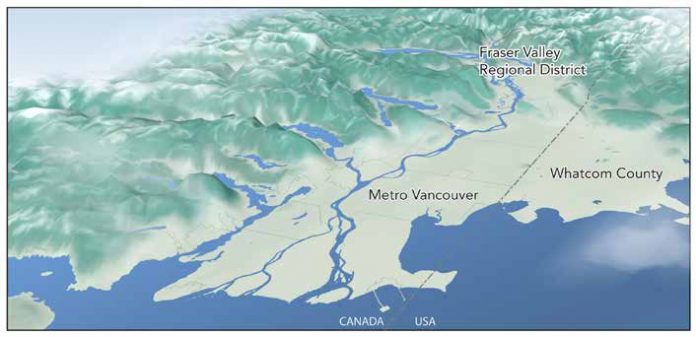 ALTHOUGH Metro Vancouver’s air quality was significantly affected by unprecedented levels of wildfire smoke last summer, smog-forming pollutants are anticipated to continue declining over the next 20 years, according to the latest Caring for the Air report for 2019.
ALTHOUGH Metro Vancouver’s air quality was significantly affected by unprecedented levels of wildfire smoke last summer, smog-forming pollutants are anticipated to continue declining over the next 20 years, according to the latest Caring for the Air report for 2019.
The eighth annual report, released in conjunction with Clean Air Day, suggests regional smog-forming emissions could decrease by 10 per cent from 2015 to 2035, due to measures such as enhanced emissions standards for vehicles and appliances, lower-carbon fuels, and initiatives such as the Wood Stove Exchange program.
“Everyday activities like driving cars and heating homes unavoidably result in the discharge of air contaminants and greenhouse gases,” said Adriane Carr, Chair of Metro Vancouver’s Climate Action Committee. “Our goal is to limit peoples’ exposure to air pollution through the regulatory, education and policy tools available to us, in order to ensure that our residents have clean air to breathe.”
Every five years, Metro Vancouver conducts an emissions inventory in the region and Lower Fraser Valley air shed. In 2015, 4.7 million tonnes of greenhouse gases (GHGs) and 16,000 tonnes of smog-forming pollutants (SFP) were emitted as a result of personal vehicles on the roads in Metro Vancouver. However, overall GHG and SFP emissions are estimated to drop by 35 per cent and 70 per cent respectively by 2035, despite more vehicles on the roads, thanks to more stringent standards for fuel and vehicle emissions. Programs to increase awareness and uptake of electric vehicles can drive these reductions even further, moving us towards targets in Metro Vancouver’s Climate 2050 Strategy.
In recent years, wildfire smoke has triggered lengthy air quality advisories, with an unprecedented 22 days under air quality advisories in the summer of 2018. The smoke was primarily from fires outside the region. The increased number of advisories underscores the importance of Metro Vancouver’s extensive Air Quality Monitoring Network, which includes 31 monitoring stations from Horseshoe Bay to Hope. These stations collect data every hour, seven days a week, and make the data available to the public in real-time at www.airmap.ca. Metro Vancouver’s monitoring network is associated with the National Air Pollution Surveillance (NAPS) network, which seeks to provide accurate and long-term air quality data of a uniform standard across Canada. NAPS was established in 1969 and is celebrating its 50th anniversary.
“Climate change is having a significant effect on our air quality, especially in terms of wildfire smoke,” said Metro Vancouver Board Chair Sav Dhaliwal. “The Clean Air Plan will build on existing activities and outline new strategies that continue to protect public health and the environment, and reduce our contribution to climate change.”
A new Clean Air Plan is expected to go to the public and interested parties for feedback and comments in 2019, with adoption to be considered by the Board in 2020. Metro Vancouver is also implementing a Climate 2050 Strategy, which will guide policy and actions across the region to reduce carbon emissions and prepare for the effects of global warming.
More information can be found here: http://www.metrovancouver.org/










